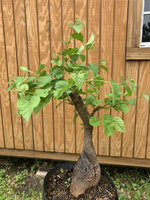Joe Dupre'
Omono
I don't know if I've ever read this anywhere, but I've been using this technique for years. I collect a lot of wild material and start with little more than a stump with maybe two or three branches. When most deciduous trees send out sprouts, they normally go almost straight up. What I do, after they have a few inches of growth , is to GENTLY massage them into a more horizontal position. It's basically the same motion as bending a wired branch, but I just bend it down in very small increments by moving an 1/8" down the branch at a time. Now, you really can't put much of a sideways bend in the branches, but I can normally get them to lay down from almost straight up to at or below the horizontal. Spoiler alert! You WILL break a few branches at first, but you'll soon learn how the individual trees react to the procedure.
This procedure saves trying to put a severe bend in a bigger branch later on. Once a branch is near horizontal, clip and grow usually kicks in and I don't need nearly as much wiring to get the design I want.
This procedure saves trying to put a severe bend in a bigger branch later on. Once a branch is near horizontal, clip and grow usually kicks in and I don't need nearly as much wiring to get the design I want.


